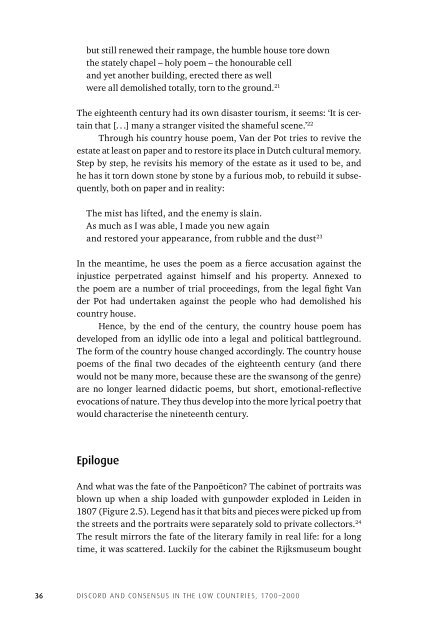Discord Consensus
7aze300jFJo
7aze300jFJo
Create successful ePaper yourself
Turn your PDF publications into a flip-book with our unique Google optimized e-Paper software.
ut still renewed their rampage, the humble house tore down<br />
the stately chapel –holy poem –the honourable cell<br />
and yet another building, erected there as well<br />
were all demolished totally, torn to the ground. 21<br />
The eighteenth century had its own disaster tourism, it seems: ‘It is certain<br />
that [. . .] many a stranger visited the shameful scene.’ 22<br />
Through his country house poem, Van der Pot tries to revive the<br />
estate at least on paper and to restore its place in Dutch cultural memory.<br />
Step by step, he revisits his memory of the estate as it used to be, and<br />
he has it torn down stone by stone by a furious mob, to rebuild it subsequently,<br />
both on paper and in reality:<br />
The mist has lifted, and the enemy is slain.<br />
As much as I was able, I made you new again<br />
and restored your appearance, from rubble and the dust 23<br />
In the meantime, he uses the poem as a fierce accusation against the<br />
injustice perpetrated against himself and his property. Annexed to<br />
the poem are a number of trial proceedings, from the legal fight Van<br />
der Pot had undertaken against the people who had demolished his<br />
country house.<br />
Hence, by the end of the century, the country house poem has<br />
developed from an idyllic ode into a legal and political battleground.<br />
The form of the country house changed accordingly. The country house<br />
poems of the final two decades of the eighteenth century (and there<br />
would not be many more, because these are the swansong of the genre)<br />
are no longer learned didactic poems, but short, emotional-reflective<br />
evocations of nature. They thus develop into the more lyrical poetry that<br />
would characterise the nineteenth century.<br />
Epilogue<br />
And what was the fate of the Panpoëticon? The cabinet of portraits was<br />
blown up when a ship loaded with gunpowder exploded in Leiden in<br />
1807 (Figure 2.5). Legend has it that bits and pieces were picked up from<br />
the streets and the portraits were separately sold to private collectors. 24<br />
The result mirrors the fate of the literary family in real life: for a long<br />
time, it was scattered. Luckily for the cabinet the Rijksmuseum bought<br />
36<br />
DISCORD AND CONSENSUS IN THE LOW COUNTRIES, 1700–2000


